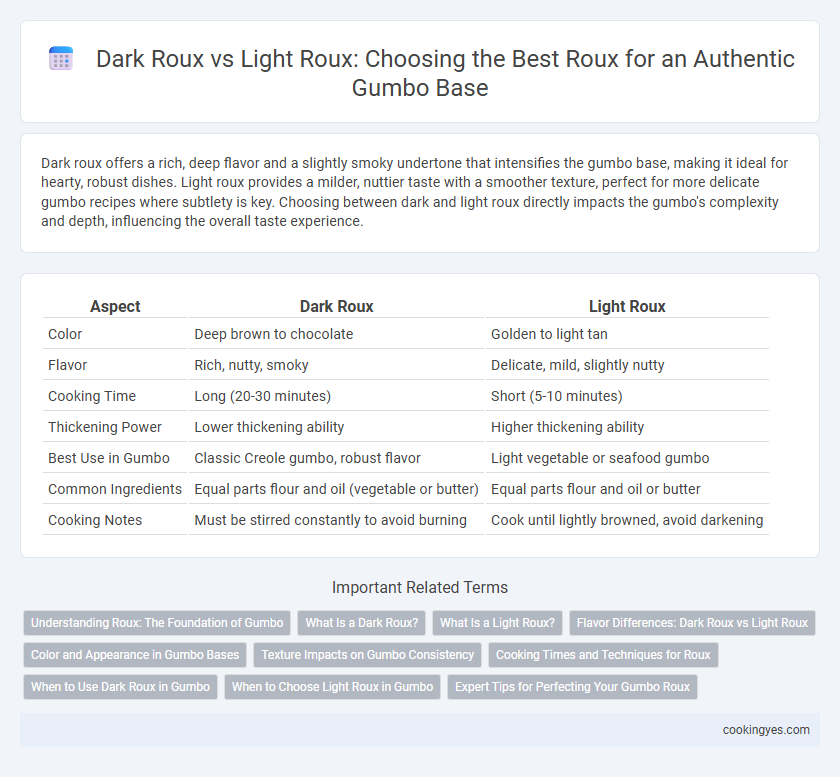Dark roux offers a rich, deep flavor and a slightly smoky undertone that intensifies the gumbo base, making it ideal for hearty, robust dishes. Light roux provides a milder, nuttier taste with a smoother texture, perfect for more delicate gumbo recipes where subtlety is key. Choosing between dark and light roux directly impacts the gumbo's complexity and depth, influencing the overall taste experience.
Table of Comparison
| Aspect | Dark Roux | Light Roux |
|---|---|---|
| Color | Deep brown to chocolate | Golden to light tan |
| Flavor | Rich, nutty, smoky | Delicate, mild, slightly nutty |
| Cooking Time | Long (20-30 minutes) | Short (5-10 minutes) |
| Thickening Power | Lower thickening ability | Higher thickening ability |
| Best Use in Gumbo | Classic Creole gumbo, robust flavor | Light vegetable or seafood gumbo |
| Common Ingredients | Equal parts flour and oil (vegetable or butter) | Equal parts flour and oil or butter |
| Cooking Notes | Must be stirred constantly to avoid burning | Cook until lightly browned, avoid darkening |
Understanding Roux: The Foundation of Gumbo
Dark roux, cooked longer to a deep brown color, delivers a rich, nutty flavor and thicker texture essential for robust gumbo, while light roux, with its pale tan hue, offers a milder, more subtle taste and smoother consistency ideal for delicate gumbo variants. Mastering the roux's color and cooking time directly influences gumbo's depth, balance, and authenticity, as it acts as the fundamental thickening and flavor-building agent. The chemical transformation of flour and fat during roux preparation unlocks complex flavors, making it a critical technique in traditional Louisiana gumbo recipes.
What Is a Dark Roux?
A dark roux is a deeply browned mixture of flour and fat cooked longer than a light roux, developing a rich, nutty flavor essential for authentic gumbo. It provides a robust base that thickens the gumbo while adding complex, toasted notes distinctive to Cajun and Creole cuisine. Unlike light roux, which is pale and mild, dark roux offers a more intense color and flavor, critical for traditional gumbo's depth and character.
What Is a Light Roux?
A light roux for gumbo is cooked briefly until it reaches a pale tan or golden color, offering a mild, nutty flavor with minimal bitterness. This type of roux acts as a thickening agent while preserving a delicate taste that complements seafood and chicken-based gumbos. Light roux requires careful attention to prevent overcooking and is essential for achieving a balanced gumbo base that highlights fresh ingredients.
Flavor Differences: Dark Roux vs Light Roux
Dark roux offers a deep, nutty flavor with a slightly smoky undertone that intensifies the gumbo's richness, while light roux provides a milder, more subtle taste that allows other ingredients to shine. The longer cooking time of dark roux develops complex caramelized notes, enhancing the overall depth of the dish. Light roux, cooked briefly, maintains a more neutral base, making it ideal for delicate or seafood-based gums.
Color and Appearance in Gumbo Bases
Dark roux offers a deep, rich brown color that intensifies the gumbo's visual appeal and contributes a robust, slightly bitter flavor profile. Light roux, appearing tan or golden, provides a smoother, nuttier taste and a lighter hue that keeps the gumbo's color brighter and more translucent. The choice between dark and light roux directly affects the gumbo's color depth and clarity, influencing both presentation and perceived richness.
Texture Impacts on Gumbo Consistency
Dark roux imparts a rich, nutty flavor and a thicker, smoother texture, creating a gumbo with a deep, velvety consistency. Light roux offers a milder taste and a slightly grainier texture, resulting in a lighter, less viscous gumbo base. Choosing between dark and light roux directly affects the gumbo's mouthfeel and overall thickness, with dark roux providing a more robust, cohesive consistency.
Cooking Times and Techniques for Roux
Dark roux requires longer cooking times, often 30 to 45 minutes, to achieve its deep, nutty flavor essential for authentic gumbo, while light roux cooks faster, usually within 10 to 15 minutes, producing a milder taste. The technique involves constant stirring over medium to medium-low heat to prevent burning, with dark roux developing a rich brown color and smoky aroma. Light roux demands less attention but careful heat control to maintain a pale tan color, balancing flavor without overpowering the gumbo's other ingredients.
When to Use Dark Roux in Gumbo
Dark roux in gumbo offers a deep, nutty flavor essential for robust Creole and Cajun dishes where richness and complexity are desired. Use dark roux when cooking gumbo with stronger proteins like sausage, smoked meats, or seafood that can balance its intense, slightly bitter notes. The longer cooking time needed for dark roux's color development enhances the stew's depth without overpowering the other ingredients.
When to Choose Light Roux in Gumbo
Light roux is ideal for gumbo recipes that emphasize a delicate, nutty flavor without overwhelming the other ingredients. It is best chosen when cooking with seafood or chicken to maintain a balanced taste and preserve the gumbo's bright, fresh elements. Light roux also requires less cooking time, offering a smoother, less bitter base that complements lighter broths and vegetables.
Expert Tips for Perfecting Your Gumbo Roux
Mastering the gumbo roux begins with choosing between dark and light roux, each providing distinct flavor profiles and cooking times crucial for authentic taste. Dark roux offers rich, deep flavors with a slightly nutty aroma but requires careful attention to avoid burning, while light roux delivers a milder, more buttery base, perfect for delicate gumbo varieties. Experts recommend slow, consistent stirring over low heat using oil and flour in equal parts to achieve the ideal texture and prevent bitterness, ensuring a perfectly balanced gumbo base.
Dark roux vs light roux for gumbo base Infographic

 cookingyes.com
cookingyes.com